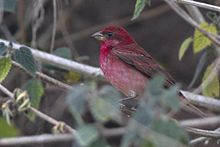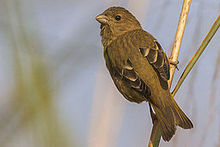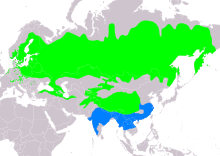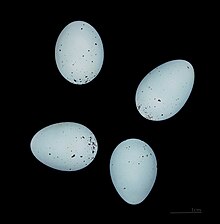Common rosefinch
| Common rosefinch | |
|---|---|

| |
| Male from Neora Valley National Park, West Bengal, India | |

| |
| Female at Baur reservoir in Uttarakhand, India | |
| Scientific classification | |
| Domain: | Eukaryota |
| Kingdom: | Animalia |
| Phylum: | Chordata |
| Class: | Aves |
| Order: | Passeriformes |
| Family: | Fringillidae |
| Subfamily: | Carduelinae |
| Genus: | Carpodacus |
| Species: | C. erythrinus
|
| Binomial name | |
| Carpodacus erythrinus (Pallas, 1770)
| |

| |
| Range of C. erythrinus Breeding Non-breeding
| |
| Synonyms | |
|
Erythrina erythrina | |
The common rosefinch (Carpodacus erythrinus) or scarlet rosefinch is the most widespread and common rosefinch of Asia and Europe.
Taxonomy
In a molecular
The genus name is from Ancient Greek karpos, "fruit" and dakno, "to bite", and the specific erythrinus is from Latin erythros, "red".[5]
Description
The common rosefinch is 13–15 cm (5.1–5.9 in) in length.[6] It has a stout and conical bill. The mature male has brilliant rosy-carmine head, breast and rump; heavy bill; dark brown wings with two indistinct bars, and a white belly. Females and young males are dull-colored with yellowish-brown above, brighter on the rump and greyer on head; buff below.
Adults moult in their winter quarters, between September and November. After moulting the red of male is subdued, and becomes brighter during the winter due to wear of the feathers.[7]
A rare form exists, in which the red colouring of males is replaced by yellow. The cause is environmental, rather than genetic, being affected by diet and the presence of parasites[8]
Distribution and habitat
It has spread westward through
They are found in summer in thickets, woodland and forest edges near rivers and in winter in gardens and orchards, wetlands and locally in dry oak woods.[citation needed]
Behaviour

The nest is placed low in a bush. The eggs are dark blue with coarse dark brown spots, and a typical clutch contains five eggs.[citation needed]
References
- . Retrieved 12 November 2021.
- PMID 22023825.
- .
- ^ Gill, Frank; Donsker, David (eds.). "Finches, euphonias". World Bird List Version 5.2. International Ornithologists' Union. Retrieved 5 June 2015.
- ISBN 978-1-4081-2501-4.
- S2CID 226003706. Retrieved 12 July 2015.(subscription required)
- ISBN 978-1-4729-0647-2
- ^ Harrop, Andrew H. J. (December 2023). "Yellow Common Rosefinches". British Birds. 116 (12): 732–734.
- ^ "Pintarroxo-vermelho: Carpodacus erythrinus". avesdeportugal.info. Retrieved 13 November 2020.
External links
- Oiseaux Photos
- OBC Archived 2017-08-03 at the Wayback Machine 39 photographs (see pulldown menu at page bottom)
- Avibase[permanent dead link]

